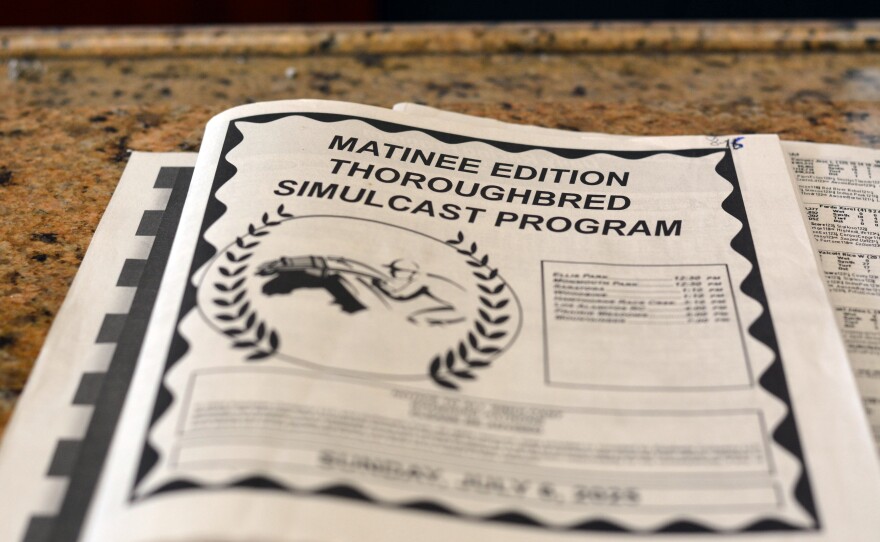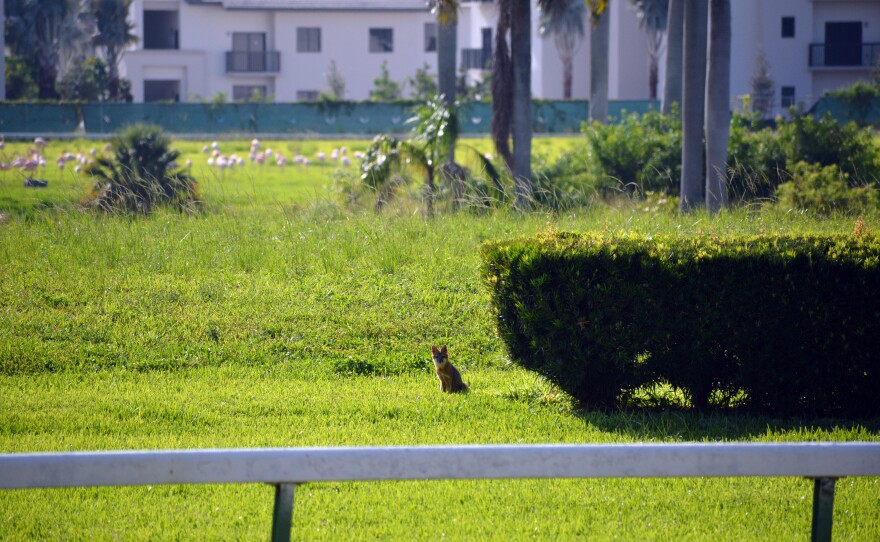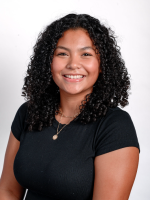
From Palm Beach County to Miami-Dade, 11 cities are celebrating their centennials in 2025 and 2026. WLRN News' series "History We Call Home" spotlights the moments, ideas and people that made these cities part of our community's fabric over the past century.
In 1930, wealthy thoroughbred horse breeder Joseph Widener had a vision for his newly purchased racetrack in Hialeah.
He was willing to spend millions to restore what was then called the Miami Jockey Club. It had been devastated by the Great Miami Hurricane of 1926.
“He had traveled all around the world," said Ken Wilde, historian with the Miami Springs Historical Society and Museum. "There's a famous track in France called Longchamp, and that was supposed to be the most beautiful track in the world. He fashioned Hialeah Racetrack after Longchamp.”
Widener reopened it as the Hialeah Park Racetrack in 1932.
But he wanted something that the well-established Longchamp Racecourse didn’t have and that could even make some Parisians jealous: A flock of pink flamingos.
He built a shallow lake with four islands in the middle of the racecourse and in 1934, shipped in about 20 of the elegant pink birds from Cuba.
READ MORE: 'It’s like the Statue of Liberty': Miami’s Freedom Tower set to turn 100
“The next day, they were all gone, because they didn't clip their wings,” said Wilde. “They didn't think they were gonna fly away.”
It would not stop Widener from importing even more flamingos three years later. This time, they clipped their wings.
“At some point they stopped clipping their wings and they didn't fly away anymore, and they started having babies,” said Wilde.
Listed in the National Register of Historic Places in 1979, the racetrack and its flamingos have become a symbol for the city of Hialeah — which this year celebrates its centennial anniversary.

The racetrack's beginnings — and Hialeah's
Before the Great Miami Hurricane struck, everything in the nascent city of Hialeah revolved around its racetrack.
The city's co-founders Glenn Curtis, an aviation pioneer, and James Bright, a Missouri cattleman, provided acres of land to develop the area where the racetrack sits today.
“They were developing Hialeah and they wanted to attract people to the town,” said Wilde.
The wealthy from near and far enjoyed its attractions, which at its inception in 1925 — the same year that Hialeah was incorporated — featured both greyhound and thoroughbred racing, the first Jai Alai fronton in the Miami area and one of the largest rollercoasters for its time.
Thousands of people and well-known names — most famously Sir Winston Churchill in 1946 — would flock to the racetrack during its heyday and take a peek at the pink wading birds.
“It attracted thousands of people every night. They had busloads of people coming from downtown Miami and all around Miami,” said Wilde.
Meanwhile the working class, largely laborers from the nearby historically Black neighborhood of Seminola, took on jobs to help build and maintain the racetrack grounds — especially in the racetrack’s early days.
The 1926 hurricane would bring it all crumbling down intro debris just a year later, along with a majority of homes in Hialeah and South Florida. According to the city of Hialeah, over 70% of all buildings suffered massive structural damage.
But when Widener took the reins of the racetrack years later, he would prove to have made it into an even bigger spectacle, carrying on a legacy for almost 70 years.
Thousands of people and well-known names — most famously Sir Winston Churchill in 1946 — would flock to the racetrack during its heyday and take a peek at the pink wading birds.
One of the most popular events of the year was Flamingo Day, also known as Flamingo Stakes.
“It used to be $100,000 added stakes,” said Wilde. “ Everybody wore pink and it was all about the flamingos.”
The flamingos are now part of the city’s official logo, and statues of the birds decorate the Hialeah Fountain on East 8th Avenue. Hialeah’s famous birds also inspired the logo for the Florida Lottery in 1986.
But despite the racetrack’s cultural significance and popularity, the last thoroughbred horse race was in 2001. A change in state law that year made it harder to compete with other racetracks like Gulfstream Park in Hallandale.
And although it became Hialeah Park Casino in 2013, the racetrack flamingos that live in Miami-Dade County’s second-largest city no longer have a crowd of thousands of spectators. Only the faint sounds of traffic and construction in the distance.
Once a racetrack worker, now the chronicler of Hialeah’s flamingos
Wilde began working at the Hialeah racetrack soon after graduating with the class of 1963 from Archbishop Curley Notre Dame High School.
He grew up in nearby Miami Springs, and his father had worked as a racetrack cashier during horse racing season. Wilde’s stepfather also worked at the racetrack as a night watchman — and then as an ambulance driver that followed jockeys and their horses around during races and training, in case of injury.
“[My] first job was a roofers' helper, it was baptism by fire. I mean, in June and July … lugging buckets of hot tar around,” said 79-year-old Wilde.
For the next five years, Wilde took on “ every kind of job you can imagine in maintenance.” He worked with the team that installed the aluminum canopy that still hovers over the stands today, and one summer, he worked with a crew of men to replace 80-feet-tall royal palm trees bordering the wall — which no longer exists — on East Fourth Avenue.
“I was helping trim one of those royal palm trees and I lost my high school ring,” said Wilde. “I searched and searched, I went back after work, and that's where my high school ring is, buried in there somewhere.”
Wilde's love for flamingos began when he started working at the racetrack.
“Every once in a while I would help mix the food for the flamingos,” said Wilde. He recalls the birds having a diet of shrimp and rice.
At almost 80, the racetrack and its flamingos keep the local historian coming back — it has become a place of tranquility and nostalgia.

“ Once a month I come over here whenever my wife has a doctor's appointment near Hialeah Hospital,” said Wilde one hot July morning at the racetrack, wearing a short-sleeved, bright pink button-up shirt covered in flamingos. “I'll come over here and spend 15 or 20 minutes.”
In addition to being the city of Miami Springs’ official historian, Wilde also runs The Miami Springs Historical Society and Museum Facebook page. With old photographs, videos and newspaper clippings of Miami Springs, Hialeah and occasionally even Miami through the decades, the page has garnered a following of over 40,000 people.
Wilde also helped curate an exhibit at the museum about the history of flamingos in Hialeah and Miami Springs.
As Hialeah Park transforms, the flamingos remain
At one point, Hialeah Park had more than 300 flamingos.
A 2023 count conducted by the Tropical Audubon Society found 96 flamingos still living in the racetrack’s infield. The racetrack has also been a vital location for helping zoos develop sustainable populations of American flamingos outside of the wild.
“They have had great success over the years having their flock nest and reproduce,” said Frank Ridgley, head of Zoo Miami’s Conservation and Research Department. “For many years, this was one of the only populations where accredited zoos in North America could source new young birds or eggs to build their flock sizes up.”
Hialeah Park now diversifies as an entertainment venue and casino that features slot machines, live poker and electronic table games. It also simulcasts horse races that are happening at other tracks across the country.
It’s what the Brunetti family, who have owned the racetrack since the late 70s, transformed it into after halting thoroughbred racing.
But the biggest change that the racetrack has endured in more recent years is the development of over 300 apartment units and a charter school on what used to be vacant space on its grounds. Construction is still underway.
“ The track itself and the clubhouse and the grandstand and the paddock area are all historically protected areas,” said Wilde. “If it takes condominiums or apartment houses in an empty parking lot to keep the place open, to pay the bills, I don't fault them.”
Through all the changes in the last 100 years of the track, the pink flamingos still stand with a natural elegance like no other — with no plans to leave Hialeah anytime soon.
And Wilde’s adoration for the racetrack and its famous pink residents still remains.
“The ashes of over 200 Hialeah Park lovers are scattered there,” said Wilde about the Hialeah Park Racetrack. “When the time comes, some of my ashes will join them.”















